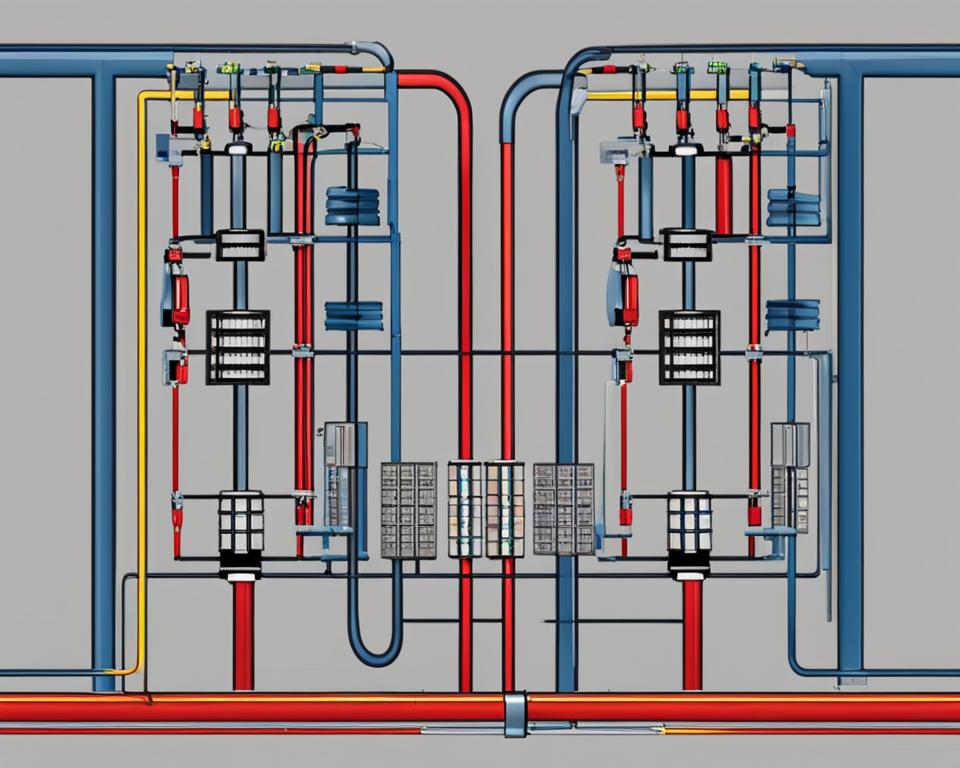In electricity, the difference between single-phase and three-phase power lies in the distribution of the load. Single-phase power is a two-wire alternating current (AC) power circuit, with one power wire (phase wire) and one neutral wire. Three-phase power, on the other hand, is a three-wire AC power circuit with each phase AC signal 120 electrical degrees apart.
Typically, residential homes are served by a single-phase power supply, while commercial and industrial facilities utilize a three-phase supply. The key advantage of three-phase power is its ability to accommodate higher loads, making it more suitable for heavy equipment and machinery. Single-phase power is commonly used for lighting and heating.
Three-phase power supplies are more efficient, as they can transmit three times as much power while requiring fewer wires. Additionally, three-phase power supplies offer a consistent delivery of power, as they deliver power at a steady, constant rate.
Key Takeaways:
- Single-phase power is a two-wire AC power circuit used in residential settings for lighting and heating purposes.
- Three-phase power is a three-wire AC power circuit commonly used in commercial and industrial settings for heavy equipment and machinery.
- Three-phase power supplies are more efficient and offer a consistent delivery of power.
- Single-phase power requires two wires while three-phase power requires three or four wires.
- Understanding the difference between single-phase and three-phase power is important for determining the appropriate electrical system for different applications.
Understanding Single Phase Power
Single-phase power is a commonly used electrical system in residential settings. It operates using a two-wire system consisting of a phase wire and a neutral wire. The voltage in a single-phase power supply starts at 230 volts, with a frequency of about 50 Hertz. This type of power is best suited for loads such as lighting, fans, and smaller appliances. It is simple to operate and can effectively transmit power up to 5 Horse Power.
One of the advantages of single-phase power is its ease of installation and lower cost compared to three-phase power systems. Single-phase systems typically require fewer conductors and have simpler wiring arrangements. This makes it a popular choice for homeowners and small businesses with less demanding power requirements.
However, it’s important to note that single-phase power is not suitable for heavy equipment or motors. These devices require a higher initial torque to start, which single-phase power lacks. Therefore, three-phase power is more commonly used in commercial and industrial settings where there is a need for running heavy machinery and equipment.
Advantages of Single Phase Power:
- Simple installation and lower cost
- Suitable for residential applications
- Efficient for lighting, fans, and smaller appliances
- Can transmit power up to 5 Horse Power
Exploring Three Phase Power
Three-phase power is commonly used in commercial and industrial settings due to its ability to handle higher loads. It consists of three separate electric services, with each leg of the current reaching maximum voltage and being separated by one-third of the time completed within one cycle. The voltage in a three-phase power supply remains constant and does not drop to zero. It requires three or four wires depending on the configuration, such as wye or delta.
Three-phase power provides several advantages. Firstly, it allows for the efficient operation of large machinery and motors without the need for additional starters. This is because the three-phase power supply produces a rotating magnetic field that provides the initial torque required to start such devices. Secondly, three-phase power offers a smoother voltage waveform compared to its single-phase counterpart. When the number of phases in the supply system increases, the voltage waveform becomes even more stable. This consistent delivery of power ensures the smooth operation of equipment and reduces the risk of voltage fluctuations.
Another advantage of three-phase power is its economic efficiency. Compared to a single-phase power supply, three-phase power requires less conductor material to transmit the same amount of power. This is due to the fact that the three-phase system distributes the load evenly across the three wires, resulting in a higher power density. Additionally, three-phase power supplies are more reliable, as they can continue to operate even if there is a failure in one phase. This redundancy ensures a continuous power supply, minimizing disruptions in commercial and industrial processes.
| Advantages of Three Phase Power |
|---|
| Efficient operation of machinery and motors without additional starters |
| Stable and consistent delivery of power |
| Economic efficiency and higher power density |
| Increased reliability with redundancy in the power supply |
In conclusion, three-phase power offers numerous advantages in commercial and industrial settings. Its ability to handle higher loads, efficient operation of machinery, stable power delivery, economic efficiency, and increased reliability make it the preferred choice for powering heavy equipment and industrial processes. Understanding the benefits of three-phase power is crucial in designing and implementing electrical systems that meet the demands of commercial and industrial applications.
Key Differences Between Single Phase and Three Phase Power
Understanding the difference between single-phase and three-phase power is crucial for choosing the appropriate electrical system for different applications. Here, we will explore the key differences between single-phase and three-phase power to help you make an informed decision.
Distribution of Electricity
The primary distinction between single-phase and three-phase power lies in how electricity is distributed. Single-phase power is delivered through a single conductor, while three-phase power is transmitted through three separate conductors (or four with a neutral wire). This difference in wiring configuration allows three-phase power to handle higher electrical loads efficiently.
Voltage and Power Capacity
Another significant difference is the voltage and power capacity. Single-phase power supplies typically operate at 230 volts, whereas three-phase power supplies can carry up to 415 volts. The higher voltage of three-phase power allows it to transmit more power compared to single-phase power. As a result, three-phase power offers greater power density and can handle heavy industrial equipment and machinery more effectively.
Reliability
The reliability of the power supply also differs between single-phase and three-phase systems. In a single-phase power supply, a network failure can lead to a complete power interruption. On the other hand, a three-phase power supply remains operational even if one phase fails. This increased resilience makes three-phase power more suitable for critical applications where uninterrupted power supply is essential.
By understanding the differences between single-phase and three-phase power, you can choose the most appropriate system based on your specific requirements. Whether it’s for residential, commercial, or industrial use, selecting the right power configuration ensures optimal performance and reliability.
Conclusion
In conclusion, understanding the difference between single-phase and three-phase power is crucial in determining the appropriate electrical system for different applications. The main distinction lies in the distribution of the load and the capacity to handle higher loads. Single-phase power is commonly used for residential purposes, providing a simple two-wire system that operates at 230 volts. It is suitable for lighting and heating purposes but lacks the capacity to run heavy equipment and motors.
On the other hand, three-phase power is prevalent in commercial and industrial settings. It offers a constant and efficient power supply, capable of running heavy machinery without the need for additional starters. Operating on a three or four-wire system, three-phase power can carry up to 415 volts, providing greater power density compared to single-phase power.
Ultimately, the choice between single-phase and three-phase power depends on the specific requirements of the application. While single-phase power is suitable for residential homes, three-phase power is more efficient and accommodates higher loads, making it ideal for commercial and industrial facilities. By understanding the differences and advantages of each system, users can ensure the optimal electrical setup for their needs.
FAQ
What is the difference between single-phase and three-phase power?
The difference lies in the distribution of the load. Single-phase power is a two-wire AC power circuit, while three-phase power is a three-wire AC power circuit with each phase AC signal 120 electrical degrees apart.
Where is single-phase power commonly used?
Single-phase power is primarily used for domestic applications and residential homes. It is best suited for loads such as lighting, fans, and smaller appliances.
Where is three-phase power commonly used?
Three-phase power is commonly used in commercial and industrial settings due to its ability to handle higher loads. It is suitable for heavy industrial motors and large machinery.
How many wires are required for single-phase power?
Single-phase power requires two wires – a phase wire and a neutral wire.
How many wires are required for three-phase power?
Three-phase power requires three phase wires and a neutral wire in a wye configuration, or it can do without a neutral wire in a delta configuration.
What is the voltage of single-phase power?
Single-phase power typically operates at 230 volts.
What is the voltage of three-phase power?
Three-phase power can carry up to 415 volts.
Which is more suitable for heavy equipment – single-phase or three-phase power?
Three-phase power is more suitable for heavy equipment and motors, as it can handle higher loads and provides the initial torque required to start such devices.
Which is more efficient – single-phase or three-phase power?
Three-phase power supplies are more efficient, as they can transmit three times as much power while requiring fewer wires.
How does the power supply remain operational in a three-phase system despite a phase failure?
In a three-phase power supply, if there is a failure in one phase, the remaining two phases can continue to supply power, ensuring operational continuity.

